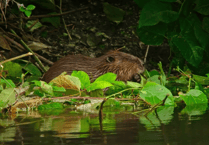A ‘well-known’ dolphin named Vader died after a rare live stranding on Ynyslas beach at the weekend.
The elderly and emaciated three-metre animal washed up alive and caught the attention of passers-by last Saturday (6 May).
A post-mortem and the resulting analysis will allow scientists to add to their understanding about the health of bottlenose dolphin populations in Cardigan Bay.
Vader, a male, was mostly seen frolicking near New Quay and he has been regularly photographed between 2008 and 2019. He was easily identified because of the distinctive notch at the base of his dorsal fin.
Dr Sarah Perry of the Cardigan Bay Marine Wildlife Centre told the Cambrian News that Vader has been frequenting the shores of Ceredigion for about 30 years - and she has known him ever since the beginning of her career. The centre's scientists said they will 'miss him'.
She said that while his death was sad, and likely due to old age, the stranding presented them with a relatively rare opportunity to analyse a dolphin. She could not remember the last time a live stranding of this kind took place.
She said: “We use dolphin dorsal fins to identify individual animals and have been doing photo ID of fins in Cardigan Bay for over 20 years now, which is part of our research.
“It gives us a little more information about areas they’re using, who they’re hanging out with, and which areas are important to them.
“We had the animal in our photo ID catalogue, so Vader was quite well known to us.
“It is very rare we get strandings and when we do it is very useful to gather information about the populations along Cardigan Bay.
“It’s highly likely this animal wasn’t very well and was struggling because it was quite thin, and its teeth were well worn but we don’t have the facts yet.
“However it is also an opportunity for us to find out more. Maybe we can see remnants of what it has been eating in its stomach.
“So, there is a lot you can gather from these not so nice events.”
It is thought bottlenose dolphins are native to Cardigan Bay and remain here most of their lives – though there is uncertainty about where they go in the winter, as they can head further north nearer Liverpool Bay. But there are sightings of them in Ceredigion throughout the year.
There are populations of dolphins in Scotland and Ireland but as far as the centre is aware they do not mix.
Marine Environmental Monitoring performs post-mortems and investigates the strandings – while Cardigan Bay Marine Wildlife Centre carries out research on their health and the way they communicate.
Matthew Westfield, Marine Environmental Monitoring's strandings co-ordinator, said: "We initially received a call to a stranded dolphin on the beach at Ynyslas (Ceredigion) around 4pm on Saturday 6 May.
"The caller didn’t know the species but informed us that the dolphin was still alive and that there was three people trying to push it back out to sea.
"We contacted the RSPCA and the British Divers Marine Life Rescue (BDMLR) to assist us in the rescue. Unfortunately the dolphin died before any of us could get their.
"Once on scene we was able to assess the animal and confirm that it was an adult male bottlenose dolphin. Bottlenose dolphins are a key species in our waters around the Welsh coast with a number of pods being seen around the coastline. It is very unusual for them to live strand.
"They are a very intelligent animal and normally only strand when unwell. By sharing the pictures we took of the dorsal fin with the Cardigan Bay Marine Wildlife Centre (CBMWC) and Sea Watch Foundation who both keep records of the dolphins around our coast we was able to find out a lot about this particular dolphin.
"We now know due to the great work these organisations do, that he was first seen in 1990 and regularly visited the New Quay area of Wales. Bottlenose dolphins can live up to 60 years, so we know this one has been around for at least 33 years which means he is an old dolphin.
"He had been seen over the years in various locations within the Cardigan bay area but hadn’t been seen recently.
"As part of the Cetacean Stranding Investigation Programme we have carried out a post-mortem on the dolphin which showed a number of age related injures. We hope to be able to confirm further details about what we found in the coming days as we get further results from samples taken."





Comments
This article has no comments yet. Be the first to leave a comment.